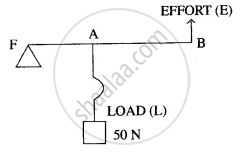Advertisements
Advertisements
प्रश्न
The length of a nut-cracker is 12 cm. A nut, when kept at a distance of 4 cm from its fulcrum, requires an effort of 100 gf to crack it. What force will be required to crack the nut without using the nut-cracker?
उत्तर
Given : Effort arm = 12 cm, Load arm = 4 cm, Effort E = 100 gf, Load L = ?
(Nut-cracker is the lever of second order)
Since, `"Load"/"Effort"=("Effort arm")/("Load arm")`
∴ `"L"/100=12/4`
or L = 300 gf.
Thus, a force of 300 gf is required to crack the nut without using the nut-cracker.
APPEARS IN
संबंधित प्रश्न
Which class of lever will always have MA > 1 and why?
What is a lever?
A lever of length 9 cm has its load arm 5 cm long and the effort arm is 9 cm long.
- To which class does it belong?
- Draw a diagram of the lever showing the position of fulcrum F and directions of both the load L and effort E.
- What is the mechanical advantage and velocity ratio if the efficiency is 100%?
- What will be the mechanical advantage and velocity ratio if the efficiency becomes 50%?
Give three examples for leavers of 1st order.
The following belong to which class of lever?
The Physical balance
The following belong to which class of lever?
A see-saw
The following belong to which class of lever?
Rowing of a boat
The following belong to which class of lever?
Wheelbarrow
The diagram below shows a lever in use.

(i) To which class of lever does it belong?
(ii) If FA = 40 cm, AB = 60 cm, then find the mechanical advantage of the lever.
A lever is used to multiply the force.
